“I think we’ll be very surprised to see where we are in a few years from now,” says Brett Bissell, Chief Operating Officer (COO) for Contract Logistics at global supply chain specialists, CEVA Logistics. By ‘we’, he means both his company and the logistics industry, which is currently confronted with trends signifying great upheaval: online retail, automation, self-driving trucks and big data. “None of these buzzwords will come as a surprise to you,” Bissell states, “but they are leading to significant changes in warehouses.”
The logistics industry is very complex because it transports goods, raw materials or spare parts from one point to another for a broad range of other industries. To make matters more complex, a container ship has little in common with an express delivery postal service. For an intralogistics company such as KION Group, two segments are of particular interest. The first is freight logistics, primarily via road, where logistics companies manage various intermediate stations and reloading points. The second is contract logistics, where customers outsource the operation of entire warehouses to logistics experts. With a European market of some EUR 400 billion and with a 40 percent share, this is easily the largest industry segment. The benefit for the customer is that they do not have to worry about staff costs, planning, or capital expenditures. Instead, they sign contracts with logistics experts. In turn, these experts are experiencing ever-shorter contracts and are under increasing pressure when it comes to costs and innovation.
Total transparency
“We have been experiencing a huge shift over the last few years,” says Erik Wirsing, the head of Innovation at DB Schenker, which, with a revenue of USD 16 billion, is one of the world’s five largest logistics companies. “Business models change and logistics are both the driving force as well as the driver. They must identify optimizations at a time of enormously enhanced transparency. It is precisely this transparency which must be consistently expanded to establish a new form of additional value along the supply chain.” Thanks to various sensor solutions, networking on online platforms and big data analysis, virtually everyone knows today what is available and where.
It even ensures that the exact temperature, possible vibrations, humidity and other consignment conditions are visible at all times and that an active alarm issues notifications about any deviations. According to Wirsing, customers previously perceived logistics as complicated and obscure. Today, customers vehemently demand transparency and the growing digital environment has also given rise to numerous innovative start-ups. Thus, established companies are up against competition like never before. “Everyone enjoys logistics,” says Wirsing; even big corporations such as Amazon and Google.
The benefits of technology
The industry giants are holding steady against the new competition, primarily thanks to their infrastructure, truck fleets and experience. “We often offer advice to our customers as well such as which innovation best suits their needs,” says Dennis Farwick, the head of Business Innovation Contract Logistics at DB Schenker.
It also means that customers expect an increasingly comprehensive service from logistics experts. “Customers no longer pay us to deploy a forklift; they pay us for service, transparent processes and delivery capability,” notes Wirsing. “Which is why it is our goal to develop digitization, then automation and finally automated processes.” These three steps, this sequence, is important to Wirsing. Only the use of digital data can be followed by the practical use of automated machines - and only then, a vehicle that can independently navigate its way can follow. “We need to obtain concrete benefits from the technology,” says Wirsing, adding, “and gain additional value for our customers and for ourselves by using them.”
Wanted! Versatile forklifts
CEVA's Bissell also sees a great deal of potential in automated industrial trucks: “They are very flexible; they are far more flexible than conveyor belts, for example,” says the COO. Flexibility is key in an industry that revolves around short-term contracts from a variety of customers and fluctuates according to the season. Logistics experts see a great deal of scope for further improvements when it comes to automated forklifts. “AGVs must be able to move even more quickly,” says Farwick. Ideally, they would move as quickly as ones with a human operator, but without the associated risk factors. However, before that can happen, there are still various technical and regulatory questions that need to be answered. Going forward, sensors must be fitted around the entire warehouse rather than merely placed on the forklift, suggests Farwick. “The truck should be able to detect that the crossroads 20 metres (66 feet) ahead is currently clear.”
Logistics companies are also looking for additional optimization potential, primarily by improving their ability to analyse processes. “If we take data from 100 forklifts carrying performing the same tasks, we can draw conclusions about their optimal use and thus establish more efficient operating procedures,” explains Bissell. He believes this is why the industry is particularly focused on standard forklifts, which can be compared to one another and can also be quickly moved from one location to the next. “It's more useful than a specialized industrial truck that can’t be used anywhere else,” says Bissell, adding, “The dream is to have a forklift that can be easily adjusted and configured to suit every task.”
“Give us your input”
When it comes to dreams, the two DB Schenker experts also have plenty of ideas: “An automated truck that immediately knows its way around a new warehouse,” says Wirsing. In general, even better sensors and scanners, which can automatically read bar codes. “Every interruption reduces the added value.” In logistics, this includes all necessary scans, data entry and enquiries. Intelligent industrial trucks might be the solution to the problem. The same logic applies to the desire for an ‘ever-lasting battery’, or at least for a drive system that can be charged as quickly as possible. Each of the suggestions ultimately aims to reduce costs and increase efficiency. “Transport logistics involves booking platforms and optimizations within the handling points. In contract logistics, however, an individual customer estimate can be requested,” says Farwick.
However, individuals do not necessarily buy technology for technology’s sake. “An innovation must add value,” says Farwick. DB Schenker is very aware that it can be sensible or even necessary to invest in innovations at an early stage. “If we start off looking only at hard, key figures, we’ll find ourselves one step behind.” It would be damaging for an industry that is always looking for ways to increase efficiency. For the same reasons, Bissell has a message for truck manufacturers such as Linde MH. “Give us your input! We need your ideas regarding where we can make improvements and implement new technologies.” Or, as Wirsing puts it, “We need partners. The world is turning ever faster.”




_1200x674_image_546x307.jpg)